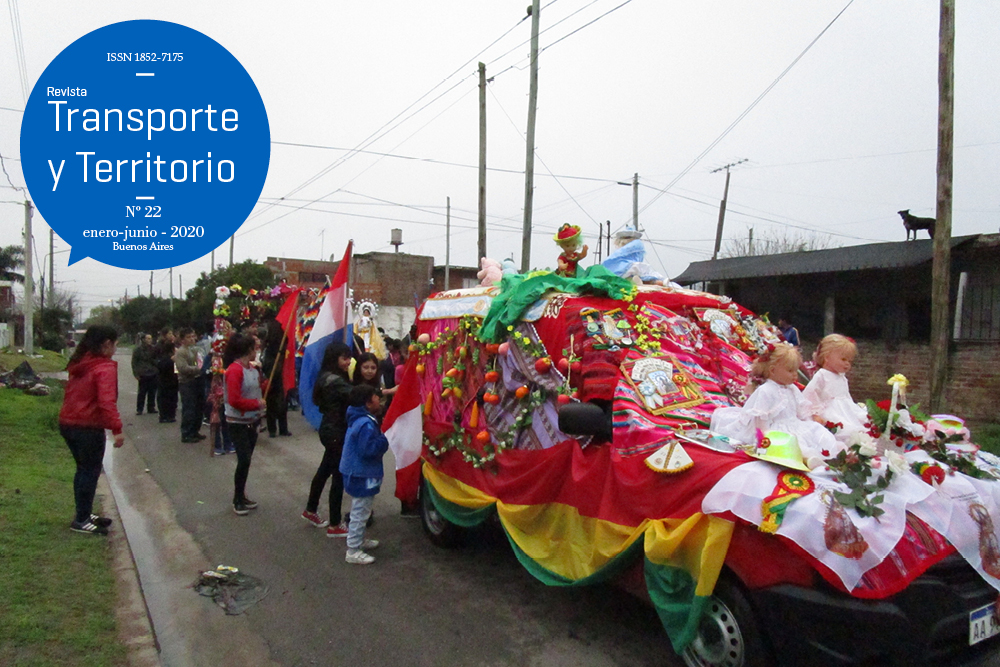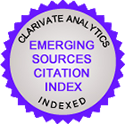Visualización de las dimensiones espaciales y temporales de las estrategias de movilidad individual en entornos urbanos
Resumo
La movilidad cotidiana, entendida como la suma de los desplazamientos recurrentes para acceder a bienes y servicios en un territorio determinado (Miralles-Guasch & Cebollada, 2009), se estudia desde una perspectiva espacio-temporal de acciones cotidianas como el uso de tecnología, los gastos monetarios y las relaciones cotidianas que configuran las estrategias de movilidad de las personas. Por medio de los Sistemas de Información Geográfica (SIG), es posible aplicar un conjunto de herramientas geográficas capaces visualizar la dimensión espacio-temporal de las actividades y los viajes individuales de las estrategias de movilidad. Su aplicación se ejemplifica en dos individuos del barrio Valle Noble de la comuna de Concepción, Chile, identificando las áreas de la ciudad en las que se mueven y sus actividades claves que permiten desenvolverse en la vida cotidiana. En detalle, se representa cartográficamente la localización de sus actividades, la amplitud e influencia de sus relaciones cotidianas, y de los elementos que influyen en la toma de decisiones en su estrategia de movilidad cotidiana.Downloads
Referências
Bagder, E. (2013). Mapping the 'Time Boundaries' of a City. CityLab. Recuperado de https://www.citylab.com/life/2013/10/mapping-time-boundaries-city/7221/?utm_source=SFFB
Büscher, M., Urry, J., & Witchger, K. (2010). Mobile Methods. London: Routledge.
Bustos, C. (2011). Formulación y análisis de indicadores del espacio de actividades de individuos del gran Concepción: caso de las actividades sociales. Concepción: Universidad de Concepción.
Carrasco, J.A., Hogan, B., Wellman, B., & Miller, E.J. (2008). Collecting social network data to study social activity-travel behavior: an egocentric approach. Environment and Planning B: Planning and Design, 35, 961-980. doi: 10.1068/b3317t
Cresswell, T (2010). Towards a politics of mobility. Environment and Planning D: Space and Society 28 (1): 17–31.
Chen, C., Ma, J., Susilo, Y., Liu, Y., & Wang, M. (2016). The promises of big data and small data for travel behavior (aka human mobility) analysis. Transportation Research Part C: Emerging Technologies, 68, 285–299. doi: 10.1016/j.trc.2016.04.005
Farber, S., Neutens, T., Miller, Harvey, & Li, X. (2013). The Social Interaction Potential of Metropolitan Regions: A Time-Geographic Measurement Approach Using Joint Accessibility. Annals of the Association of American Geographers, 103(3), 483-504. doi: 10.1080/00045608.2012.689238
Farber, S., Neutens, T., Carrasco, J., & Rojas, C. (2014). Social Interaction Potential and the Spatial Distribution of face-to-face Social Interactions. Environment and Planning B: Planning and Design, 41, 960–976. doi: 10.1068/b120034p
Fincham, B., Mcguinness, B., & Murray, L. (2010). Mobile Methodologies. London : Palgrave Macmillan.
Gao, S., Yang, J., Yan, B., Hu, Y., Janowicz, K., & McKenzie, G. (2014). Detecting Origin-Destination Mobility Flows From Geotagged Tweets in Greater Los Angeles Area. Eighth International Conference on Geographic Information Science (GIScience’14). Recuperado de https://pdfs.semanticscholar.org/5c0d/c468c0bce57483eb8d1382d7e4161b92e035.pdf?_ga=2.129812559.2122849731.1526588189-160481937.1526588189
Geertz, C. (1998). Deep Hanging Out. New York: The New York Review of Books.
Getis, A., & Ord, J. K. (1992). The Analysis of Spatial Association by Use of Distance Statistics. Geographical Analysis, 24(3), 189-206. doi: 10.1111/j.1538-4632.1992.tb00261.x
Gutiérrez, A. (2010). Geografía, Transporte y Movilidad. Scribd. Recuperado de https://es.scribd.com/document/257578071/Geografia-Transporte-y-Movilidad
Gutiérrez-Puebla, J., Garcia-Palomares, J. C., & Salas-Olmedo, M. H. (2016). Big (Geo) Data en Ciencias Sociales: Retos y Oportunidades. Revista de Estudios Andaluces, 33, 1-23. doi: 0.12795/rea.2016.i33.01
Huang, Q., & Wong, D. (2015). Modeling and Visualizing Regular Human Mobility Patterns with Uncertainty: An Example Using Twitter Data. Annals of the Association of American Geographers, 105(6), 1179-1197, doi: 10.1080/00045608.2015.1081120
Jirón, P., Lange, C., & Bertrand, M. (2010). Exclusión y Desigualdad Espacial: Retrato desde la Movilidad Cotidiana. Revista INVI, 25(68), 15-57. doi: 10.4067/S0718-83582010000100002
Jirón, P., Cortés, S. (2011). Mobile relations, mobile shadows. Understanding contemporary urban daily living through shadowing techniques. In Urban daily mobility and urban social exclusion in Santiago de Chile. International Workshop: The Everyday Life of Multi-Local Families. Concepts, Methods and the Example of Post-Separation Families, Munich, Alemania.
Jirón, P., & Mansilla, P. (2013). Hacia una re-conceptualización teórico-metodológica de la accesibilidad para comprender la exclusión social urbana en Santiago de Chile. Congreso Chileno de Ingeniería de Transporte, Santiago, Chile.
Kim, H.-M., & Po Kwan, M. (2003). Space–time accessibility measures: a geocomputational algorithm with a focus on the feasible opportunity set and possible activity duration. Journal of Geographical Systems, 5, 71-91.
Kung, K. S., Greco, K., Sobolevsky, S., & Ratti, C. (2014). Exploring Universal Patterns in Human Home-Work Commuting from Mobile Phone Data. PloS One, 9(6). doi: 10.1371/journal.pone.0096180
Luo, F., Cao, G., Mulligan, K., & Li, X. (2016). Explore spatiotemporal and demographic characteristics of human mobility via Twitter: A case study of Chicago. Applied Geography, 11–25. doi: 10.1016/j.apgeog.2016.03.001
Miralles-Guasch, C., & Cebollada, A. (2009). Movilidad Cotidiana y Sostenibilidad. Una Interpretación desde la Geografía Humana. Boletín de la Asociación de Geógrafos Españoles, 50, 193-216.
Neutens, T., Versichele, M., & Schwanen, T. (2010). Arranging place and time : a GIS toolkit to assess individual and joint accessibility to urban opportunities. Applied Geography, 30(4), 561–575.doi: 10.1016/j.apgeog.2010.05.006
Po Kwan, M., & Schwanen (2016). Geographies of Mobility. Annals of the American Association of Geographers, 106(2), 243-256, doi: 10.1080/24694452.2015.1123067
Resch, B., Hillen, F., Reimer, A., & Spitzer, W. (2013). Towards 4D Cartography – Four-dimensional Dynamic Maps for Understanding Spatio-temporal Correlations in Lightning Events. The Cartographic Journal, 50(3), 266-275. doi 10.1179/1743277413Y.0000000062
Rojas, C., Muñiz, I. & García–López, M. (2009). Estructura Urbana y Policentrismo en el Área Metropolitana de Concepción. Revista Latinoamericana de Estudios Urbanos Regionales EURE, 35(105), 47-70. Recuperado de http://www.eure.cl/index.php/eure/article/view/1391
Rueda, S., Cáceres, R., Cuchí, A., & Brau, L. (2012). El Urbanismo Ecológico. Barcelona: BCNecologia.
Sabaté, A., Rodríguez, J., & Díaz, M. (1995). Género y Espacio Cotidiano. Una Perspectiva Local e Individual. En Mujeres, Espacio y Sociedad: hacia una Geografía del Género, SÍNTESIS, 288-315.
Salas-Olmedo, M. H., & Rojas, C. (2017). The use of public spaces in a medium-sized city: from Twitter data to mobility patterns. Journal of Maps, 13(1), 40-45. doi: 10.1080/17445647.2017.1305302
Shaw, S-L., Yu, H., & Zhao, Z. (2013). A Custom Extension of Extended Time-Geographic Framework Tools in ArcGIS. U.S. National Science Foundation Grant.
Sobolevsky, S., Sitko, I., Combes, R. T., Hawelka, B., Arias, J. M., & Ratti, C. (2014). Money on the Move: Big Data of Bank Card Transactions as the New Proxy for Human Mobility Patterns and Regional Delineation. The Case of Residents and Foreign Visitors in Spain, IEEE International Congress on Big Data. Washington, DC, USA. Recuperado de https://ieeexplore.ieee.org/document/6906771/
Song, G. (2015). Spatio-Temporal Analytics for Exploring Human Mobility Patterns and Urban Dynamics in the Mobile Age. Spatial Cognition & Computation, 15(2), 86-114. doi: 10.1080/13875868.2014.984300
Steiger, E., Westerholt, R., Resch, B., & Zipf, A. (2015). Twitter as an indicator for whereabouts of people? Correlating Twitter with UK census data. Computers, Environment and Urban Systems, 54, 255–265.
Wang, Q., & Taylor, J. (2015). Process Map for Urban-Human Mobility and Civil Infrastructure Data Collection Using Geosocial Networking Platforms. Journal of Computing in Civil Engineering. Doi: 10.1061/(ASCE)CP.1943-5487.0000469
Wu, W., Wang, J., & Dai, T. (2016). The Geography of Cultural Ties and Human Mobility: Big Data in Urban Contexts. Annals of the American Association of Geographers, 612-630. doi: 10.1080/00045608.2015.1121804

1.jpg)

3.png)























